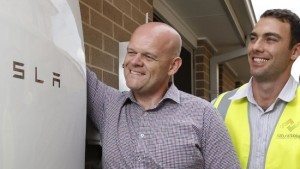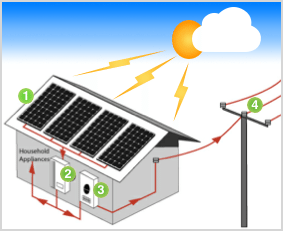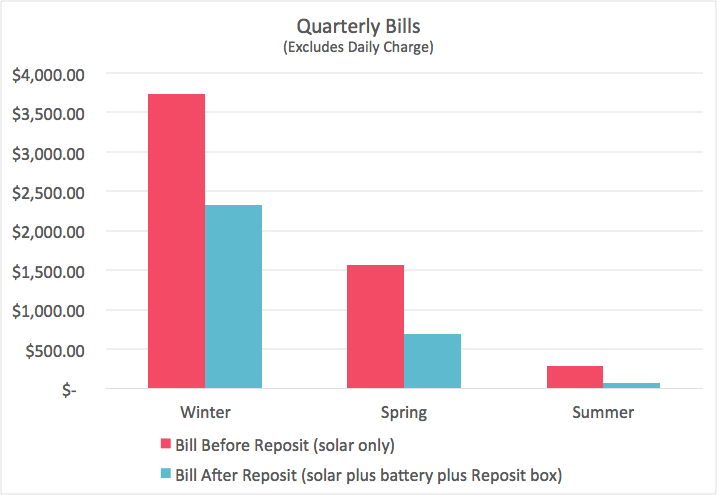Australia’s first household to add a Tesla Powerwall battery can this week begin buying and selling energy on the electricity market, after the addition of a world-leading software program by Canberra company, Reposit Power.
At the end of last month, the Pfitzner family in Kellyville Ridge, north-west of Sydney, became the first of what will soon be many Australian households to install one of Tesla’s much-hyped 7kWh batteries, to store energy generated by the house’s 5kW solar system.

On Tuesday afternoon, the same household became the first in Australia to integrate Reposit Power’s GridCredit technology with the Powerwall, to act as the “brains” of the solar plus battery storage system.
“What we do is put some smart brains on that (technology) and allow it to interact with wholesale markets,” says Reposit’s Luke Osborne.
“We want customers to be able to choose the best storage device and have a great user experience from us by trading in energy markets, buying low and selling high and supplying themselves in between.”
The “set and forget” technology – which was tested last year in a series of ARENA-backed trials based in Canberra and the surrounding region, – uses data from inputs including advanced weather forecasting and electricity market pricing to decide whether to store solar generated energy in the battery during the day or sell it back to the grid at a profit.
For example, when energy prices drop overnight and the system predicts low solar generation the following day GridCredits takes electricity from the grid to charge the batteries.
As Reposit Power CTO and co-founder Lachlan Blackhall puts it, the technology effectively turns your solar and storage into “a mini power station” that works just for you.
 “You capture excess solar when there is excess, and use it when it’s most efficient for you – when energy prices would otherwise be high,” Blackhall told One Step Off The Grid in an interview on Tuesday.
“You capture excess solar when there is excess, and use it when it’s most efficient for you – when energy prices would otherwise be high,” Blackhall told One Step Off The Grid in an interview on Tuesday.
“It also allows you to trade your energy onto the grid, via GridCredits – to sell it back to the retailer or the network or into the wholesale market.”
Blackhall says the company is now in the process of rolling out their software to hundreds of customers, and by the start of Q2, they expect that number to grow.
And while Reposit’s software is compatible with other battery technologies, the company’s early pairing with the much hyped Tesla battery – announced last May – is a feather in the young company’s cap and a great way to get on the radar.
“We are passionate about working with partners that share our vision of empowering consumers to take control of their energy future,” Blackhall told One Step. “Tesla is one such company.
“We are delighted to starting seeing the impact that Tesla batteries powered by Reposit technology will have for consumers, and the electricity grid as a whole, over the years ahead,” he said.
But battery compatibility is not the only prerequisite for households wishing to use the GridCredits technology – it also requires the cooperation of the household’s retailer or network operator.
And of course, not all of Australia’s energy industry incumbents will be thrilled with the prospect of consumers becoming active market players.
Currently, Blackhall says there is a small selection of retailers playing ball, including Diamond Energy – so far the only retailer to publicly announce it is working with Reposit (more will be announced later in the year).
According to the retailer’s website, the Diamond Energy GridCredit100 “is like a feed-in tariff. We will initiate the purchase of your battery dispatched electricity at a whopping 100 cents/kWh* during any ‘Grid Credit Event’ (when the market requires your electricity).”

“I think whenever there’s game chaining technology afoot, there’s always incumbents who feel a little bit threatened by that,” Blackhall said.
“But there is also a growing understanding of the importance of consumers who’ve spent the money on storage – that they deserve to be rewarded for that; and that their investment creates opportunities for networks.
“A lot of retail companies realise that there are opportunities here and are actively trying to take advantage of that,” he added.
Chris Williams, managing director of authorised Tesla reseller Natural Solar, agrees.
Williams told One Step Off The Grid in an interview on Tuesday that as many as 90 per cent of his new solar customers were also looking at batteries.
Of those who chose to go ahead and add battery storage with their solar, 90 per cent, he said, were opting for a Tesla. As many as a quarter of those customers were also inquiring about Reposit’s GridCredits.
The momentum among consumers to invest in this level of energy independence, he said, was driven by a combination of a desire to save money, to be green, and to get rid of the utility bill and “stick it to the man.”
“I think even people that want to save money get a great feeling when they’re helping the environment, and people who want to help the environment also like saving money,” he said.
“At the end of the day,” he added, “(solar and storage with energy management software like Reposit’s) creates market efficiency. And everyone is for market efficiency.
“If (the networks) are going to bury their heads in the sand, then they will miss out.”
This article was originally published on RE sister site, One Step Off The Grid. Click here to sign up for the weekly newsletter









